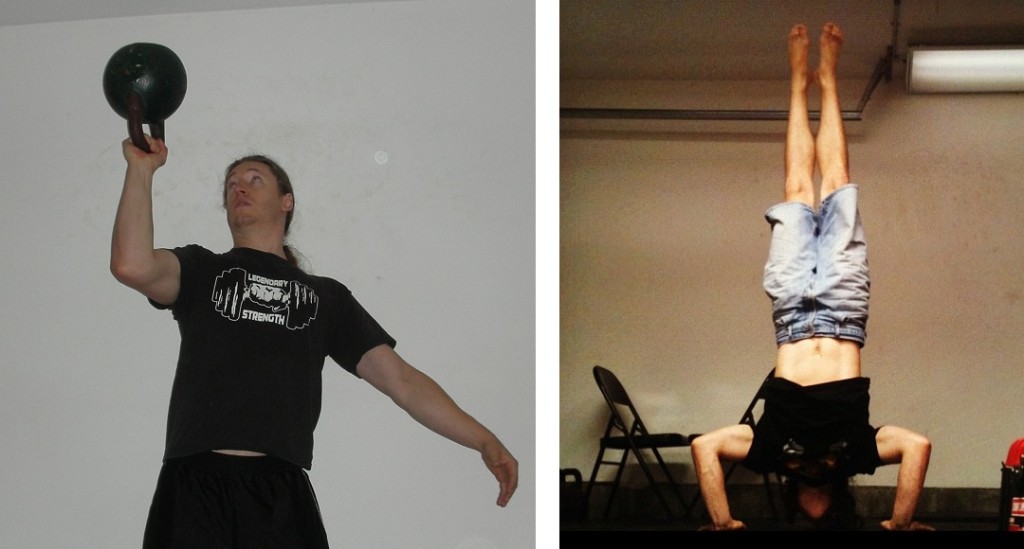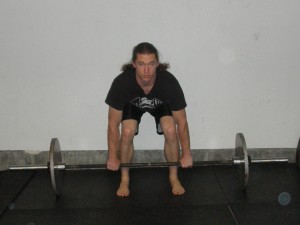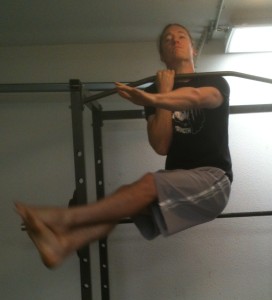This is a common question among trainees that isn’t answered real well in a lot of places. But its not difficult if you understand a few critical things. When you do effectively combining weights and bodyweight is easy to do.
There are some people that only lift weights. And there are some people that only do bodyweight training. Both forms of training have their benefits and drawbacks and thus I believe that to become the ultimate version of yourself you have to do both at least to some degree.
Yet the majority of programs out there are “tool focused”. It’s from this focus on what you use to get stronger that confusion arises. But the truth is the body doesn’t care in what way the body is loaded to get stronger. Instead we’re going to become movement focused.

Are weights or bodyweight better? Neither. In this article find out how to effectively combine them.
Movement Patterns
When you’re talking about strength training exercises there are four basic movement patterns. These include an upper body push and pull and a lower body push and pull. The is the arms moving away from the body or towards it and the legs extending to press a weight up or pull it up.
There are many more complex movement patterns as well. Many of them will be combinations of the above, like a thruster is both an upper and lower body push. Others like bridging or ab work fall outside of these categories completely.
Plus these categories could be divided into smaller chunks for instance a vertical or horizontal plane of motion. But if you just get these four basic movements than combining bodyweight and weights becomes easier.
While you can do multiple different lifts from each of the basic four movement patterns beware of doing too much or too many of them. You can get great results just focusing on as little as one exercise. Some programs don’t even cover all four movement patterns, yet they can still deliver results.
So whether you’re doing weights or bodyweight realize that the same or similar movements hit the same muscles. I don’t like to focus on the muscles used so much, but it is an important factor in recovery.
Upper Body Pushes
- Pushups
- Handstand Pushups
- Dips
- Bench Press
- Incline Press
- Military Press
- Side Press
- Push Press
- Planche
Upper Body Pulls
- Curls
- Bent Over Rows
- Upright Row
- Pullups
- Inverted Rows
- Levers
Lower Body Pushes
- Back Squats
- Front Squats
- Bodyweight Squats
- Pistols
- Jumping
- Sprints
Lower Body Pulls
- Deadlifts
- Swings
Lower body pulls is a special category. You’ll notice that there are no bodyweight exercises listed in it. That’s because there is no way to do this movement pattern without an outside object. The only way you could do it with bodyweight is to lift someone else’s bodyweight and I don’t think that counts.

There’s no way to pull like this for bodyweight training.
While you could still be fairly strong at pulling in this manner without ever working on it, only doing bodyweight will leave this as a gap. The same is true if you skipped out completely on any category.
Special Cases
Snatches and cleans could be put into the lower and upper body pull categories as similar muscles come into play for both. Although the weight is lifted overhead in a jerk, it is more of a lower body push than anything else. A muscle up is both an upper body push and pull.
Big Mistakes
Understand that most of the failure in training in combining these two will come as a result of overtraining from doing too much volume, intensity and/or frequency. In enthusiasm many people err on the side of more rather than little. Trust me, I speak from experience.
A big mistake that many trainees make is to combine two programs together that don’t belong together. If someone puts out a program it (at least it should be) is complete by itself. So if you combine both a weight and bodyweight program together without altering them you’re going to be doing too much. An example would be Greasing the Groove for a couple bodyweight exercises on top of a weightlifting program. Each by itself could be great, but together will more than likely be too much.
A similar mistake is to alternate days of training, thinking that you’ll keep it easy but you end up with six days a week, sometimes two workouts a day! This can work but it will often lead to overtraining. If you work intensely on one exercise or day you’ll need some amount of recovery for that. To think you can do light work (which isn’t always that light) the next day to recover may stop your gains. Just cause its bodyweight exercises doesn’t mean its any easier on the body or requires less recovery time.
I’ve made all these mistakes myself over the years. One time (okay it probably took me over half a year to figure it out) I was trying to increase my kettlebell press. But on my off days I was doing hand balancing and handstand pushups. In the end it was too much and I didn’t progress in anything very well. I only made some progress after taking a couple days off completely.
Differences in Upper and Lower Body Strength
I will offer this additional advice. With the upper body you can go basically as far as you want with bodyweight training. Until you’re doing one arm pullups and handstand pushups with ease there is much more room for improvement.
With the lower body it’s a little different. Most people, with some work, can build up to one legged squats. These can be weighted or done for high reps (and there are more advanced variations) but its still not the nearly limitless progression as the upper body. Not to mention you have the lack of lower body pulls as already mentioned.

You can go further with bodyweight training for the upper body than the lower.
For this reason, many people that like to combine weights and bodyweight, end up focusing more on bodyweight exercises with the upper body and weights for the lower body. This works and it works well. Try it out for yourself and see.
That being said I think ultimately you’ll get even stronger if you do vary it up from time to time. As an example doing some overload in pressing with partials, heavy benching, push presses and more, will likely in some way help your bodyweight pushing strength.
How to Successfully Combine Weights and Bodyweight
Here are five different options that can work if you do them right.
#1 – One Exercise Per Movement Pattern
The first option is to only choose one exercise from each of the major movement patterns and work on it for a period of time. Thus your main exercises may be handstand pushups, pullups, back squats and deadlifts. This doesn’t mean you can’t do additional exercises but your focus will be on these main ones. Notice in two categories it’s a weighted exercises and in the other two its bodyweight, but it could be three to one just as well.
This option works really well. Another example could be military press, bent over rows, sprints and swings. A bit different but still workable.
#2 – Alternate Workouts
The second option is to alternate workouts. If you’d normally do two squat workouts in a week you would do one with bodyweight and one with weights. This can be applied to all the movement patterns.
This could take form in different ways. With three upper body press workouts you might do bench press on one day, kettlebell presses another, and higher rep pushups on the third. Here you have three exercises, two with weights and one bodyweight. Done properly it will work.
#3 – Intensive Mixed Days
The third option is intensive mixed days. This one is slightly more advanced and will take some building up to. Here you’ll probably only do one day per week of an movement group like a squat day. But instead of one exercise you can do multiple. Do heavy squats and follow this up with bodyweight squats. You can also do the reverse which is even more demanding.
I recommend you check out Twisted Conditioning from Bud Jeffries for more ideas on this.
#4 – Alternate Weight or Bodyweight Focused Programs
The fourth option is to alternate focus over time. Do four weeks, or six months, or whatever time period you want of all bodyweight training (or mostly). Then switch your focus to all weights (or mostly). This is something I’ve done with great success.
I love to lift weights and I love bodyweight training too. I also get bored fairly easily. Thus I usually focus on something until I reach my goal or I lose my drive to do it, then I’ll switch up my training significantly. You still need to be consistent, it can’t be a change every week, but I think more variety over the long haul will make you stronger.
When doing this you can put your old exercises on maintenance mode with a little training, or forget them all together for the time being. You’ll likely loose some ground with them but this can always be built back up, usually fairly quickly. Sometimes you may even find you’re stronger when you come back to something you haven’t done in a long time which means you’re other training has had great carryover.
One reason I like this option is because the format of weight lifting workouts and bodyweight training has a bit of different form for me these days. When you move beyond the basic bodyweight exercise you get into much more skill based training. Thus this practice session is quite a bit different than how I like to approach weights.
#5 – Goal Directed
This option can be reflected in any of the others. The idea here is to completely base your training on your goals as far as what YOU want to do. Not what someone says you should do, or to do a program exactly how it is outline in a book or video. This is what I personally do, along with listening to my body.
I have goals for weights. I have goals for bodyweight exercises. Since I can’t do it all I look at a few different factors.
What are my highest priority goals?
What goals fit together well (and don‘t contradict each other)?
These two factors are looked at together to base my training program off of it. If I want to achieve a certain goal over any other that becomes my main factor in training. Then I look at my second priority, third and so on.
I also need to look at how they all fit together. For example right now I’m bending. From past experience I’ve found that I can’t do that and hand balancing at the same time. It’s too much wrist intensive work. Thus since I’m focused on bending, my hand balancing is currently sidelined. Once I achieve my bending goal I’ll be getting back to handstands.
Conclusion
While there is more specific detail that can be discussed this is more than enough to set you on the right path. As with any training just be sure to watch the factors of intensity, volume and frequency to be sure you don’t overtrain (or undertrain) and you’ll make progress. That is the ultimate test for whether your program, combining weights and bodyweight or not. Whether you’re happy with the progress you’re making or you aren’t.
If you have more questions about combining bodyweight and weights write them below in the comments.

Comments
Makes a lot of sense, Logan, thanks!
Hey Logan, the length was fine. Still a fairly quick read, but thorough with different options to choose from to combine the two. Nice emphasis on over-training with the example on how you did it to yourself. I used to be in the school of “push harder”, but over the years I’ve come to accept “push a little less”. That doesn’t mean don’t put out some intense effort, just limit the movements and duration.
Thanks, Logan. This is really good information. Between this and the information from your inner circle you have really expanded my mind. It all makes a lot of sense, especially the information on progressions. I love this kind of highly informative article and the ones on the old time strongmen.
Nice article Logan,
currently doing a bodyweight program myself.
Working on pull ups, dips, pistols, bridging, one arm pushups.
Have added weights with one arm rows, Get ups, deadlifts & tie weights to myself for dips.
It will work as well as any other programme.
Great article Logan! Right now I am more weights focused and will move to more bodyweight after achieving some goals.
Great article Logan the “how” of combining bodyweight and external weights is an important component for me as I ever pursue a Unified Theory of Training. I have been solely focused on a progressive calisthenics program for some time now where I alternate variations of movement patterns along with intensity and volume. The variation on the intensity and volume component came from reading one of your articles and it really helped my training. It takes me 4 training sessions to cover all of the patterning, volume, and intensity bases. To use pressing as an example my training days look like this:
Monday Week 1- Wall Handstand Pushups, (High Intensity, Low Volume, Long Rest Periods)
Thursday Week 1- Standard Pushup Variations, (Low Intensity, Hi Volume, Short Rest Periods)
Monday Week 2- One Arm Pushups, (High Intensity, Low Volume, Long Rest Periods)
Thursday Week 2- Pike Handstand Pushups, (Low Intensity, High Volume, Short Rest Periods)
I would then repeat the cycle and of course I am covering the other movement patterns on each training day. If I were to integrate weights into this program I would just do the weighted movements on the High Intensity, Low Volume Days but I will not do that until I can do 15-20 reps of the more advanced bodyweight movements. Such a setup might look something like this:
Monday Week 1- Kbell Push Press, (High Intensity, Low Volume, Long Rest Periods)
Thursday Week 1- Mixed Pushups, Including 1 arms, (Low Intensity, Hi Volume, Short Rest Periods)
Monday Week 2- Floor Press, (High Intensity, Low Volume, Long Rest Periods)
Thursday Week 2- Wall Handstand Pushups, (Low Intensity, High Volume, Short Rest Periods)
Glad you all enjoyed it!
My goals are to be strong on the main compound lifts but to be strong and have good balance with bodyweight exercise.help would be appreciated putting exercises together.
Very nice explanation! What do you think if I split my workouts into 3 rounds, 1st one being weighted calisthenics( dips,pull ups) 2nd round being harder progressions of bodyweight exercises ( levers, handstands, pull up variations) and finally the 3rd round being some weight training . For example on my push day for the first round I did weighted dips , push ups for three sets. The second round was archer dips, ring dips (bulgarian dips) , archer push ups , wide deep push ups , also for 3 sets but higher rep ranges. And finally for round 3 i did dumbbel chest flys and presses. Do you think this kind of training works and should i continue with it , adding higher weights on round 1 and 3 , and trying different calishtencs in between(harder variations)?
That could definitely work. The important thing is whether or not you’re making progress with it. That’s the determining factor.
One thing to keep in mind is that with round 2, if you’re progressing to more skilled bodyweight exercises, it would be best not do them after being fatigued. So if round 1 was more of a warmup that would be fine, otherwise I would switch rounds one and two.
Well the first thought that came to mind while engrossed reading this superlative concept was DAMN ! In the most amazed and inspired manor. Being both limited in equipment and financial means, not to mention an out of control ADHD driven limited mind, the litany of resources, practical applications and honest personal experiences the aforementioned article is a great compendium. In fact, I’d bet that the legendary coach Darryl K Royal from the university of Texas longhorns would” DAMN” .From me thanks and hook em all the live long day